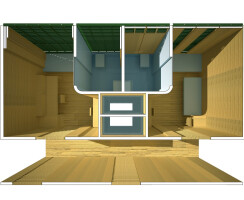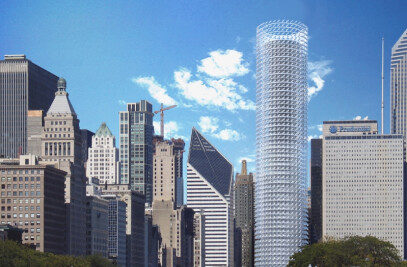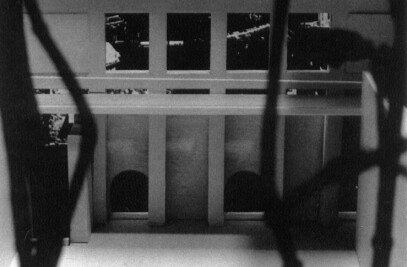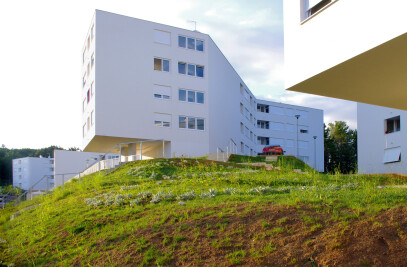“Breeze Engine” is a building in subtropical climate that is developed as a large natural ventilation equipment - a motor-less breeze engine.
High Degree of Optimization
The project is developed to achieve high degrees of optimization that are achieved through a series of inventions — similar to the inventions and optimizations leading to human flight from early gliders and flying machines to the airplane. — where characteristics, shape and use of each element is in a tight interdependent relationship with every other element.
We believe that optimization, at its best, results in unique aesthetic qualities, ingenious and admirable technology — think Tesla’s induction motor, Eames chairs or gothic cathedrals.
Breeze Engine
In order to rely on natural ventilation the building has to be optimized to its specific site conditions and to its program demands for indoor and outdoor spaces:
Location
The site is in a valley sloping down to the sea on a forested costal island in Southern China.
Climate
Southern China has a Subtropical climate similar to most of east China, the Southeast of the U.S. and other areas of the world. Hot, warm and humid climate can be expected throughout most of the year.
Microclimate
Daytime breeze from the south and nightime breeze from the north moves over the tree crowns of this forested site.
Use
A hostel, a training center, family retreat for corporate employees, and a vacation retreat for organization of elderly and disabled people are uses of this building.
The 24 required bedrooms are all one floor above ground level for better ventilation and security. Common spaces like restaurant, bar, living room and conference rooms are all on the ground level; thus integrated with the outdoor spaces on the site and the surrounding grounds, including the swimming pool and barbecue areas.
Client and their Ambition
The client is a significant international real estate developer. Their project is to showcase the client’s commitment to the environment and to be the greenest building in the region.
Building Shape and Orientation
The east-west orientation of the building ensures minimization of heat gain while providing the best exposure to air movement. The orientation allows us also to develop the building from its section, essentially extruding the principle of capturing air along the length of the building. The raised roof casts shade on the entire building including its double layer roof space above the bedroom level, thereby reducing the considerable heat load from sun exposure.
Optimized Ventilation
The natural ventilation scheme of - aerodynamic profiled windscoop roof - air channels in double layer roof - air stacks - louvered surfaces to air stacks as well as all around the building skin works in two main ways - as windscoop and as air extractor. The organization, design and location of these elements is optimized to avoid any “shading” from air movement. It is therefore optimized for the two mainly occurring scenarios: 1) constant day-time breeze from the south 2) constant night time breeze from the north
Zero carbon building
The building is designed to achieve Zero CO2 emission in collaboration with Arup Engineering, by reducing energy consumption and by adding PV panels to the available large roof surface. (See diagrams explaining the strategy on the last page of presentation)
Minimal Glass Use
The naturally ventilated building needs to be permeable while air-conditioned rooms must be sealed. Due to the optimized natural ventilation the amount of days when air conditioning is needed has been dramatically reduced; therefore, glass and air-tight material is only needed on the hottest days. Instead of using extensive glass (a material with high embodied energy), the rooms are sealed with solid, light-colored bamboo panels fitted with glass windows. The glass provides just sufficient light. Thereby the amount of glass and total amount of embodied energy is reduced. (See detail view of the bedrooms showing the glass inserted into foldable panels in the bedroom and bathrooms.)
Bamboo Structure
Finally, it is worth mentioning that it is envisioned to use bamboo for structure, finishes and furnishing of the hostel. Bamboo was traditionally used in Asia for building similar two story structures. Pioneering a contemporary bamboo structure of this kind as an initial prototype will contribute to the world effort to reintroduce this type of sustainable building construction.
This permanent habitable bamboo structure is to be developed with joints and other details, that need to be tested and approved by local codes. This effort will be a break-though for future bamboo structures which are still not allowed in most countries.
Since one of the best types of bamboo for construction is indigenous to Southern China (Moso bamboo), its availability and ease of transport to the site further contribute to its low embodied energy. Bamboo also has minimal thermal mass, a requirement for sustainable building in tropical and subtropical climates. All the blinds, shutters, finishes and furniture are also made out of bamboo. Beyond its strictly functional uses, bamboo has extraordinary aesthetic potential to create dynamic forms, lighting effects and texture.


































